| Srl | Item |
| 1 |
ID:
126294
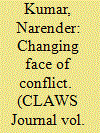

|
|
|
| 2 |
ID:
118482
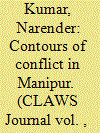

|
|
|
| 3 |
ID:
164125
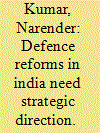

|
|
|
|
|
| Summary/Abstract |
Is there a clarity about what exactly is required from the Armed Forces in a changing regional and global security environment when national interests are spread across the continent? Big question is that, have we developed capabilities to secure India’s interests that are so varied and dispersed strategically and geographically? If India has to break out of the claustrophobic confines of South Asia, it needs certain capabilities that can propel it to be a net security provider at least in Northern Indian Ocean Region.1 However, the defence reforms or absence of these tells a different story; that India may desire to be there but the capabilities are not commensurate with the desired mandate. The Government of India has appointed the Defence Planning Committee (DPC) that would be a permanent body mandated to prepare a draft national security strategy, undertake a strategic defence review, and formulate an international defence engagement strategy.2 It will be premature to pass the judgement on DPC but a doubt remains that is it duplication and add-on to the existing cumbersome national security structure? Appointment of DPC should not be confused with the defence reforms as these are two different aspects.
|
|
|
|
|
|
|
|
|
|
|
|
|
|
|
|
| 4 |
ID:
172641
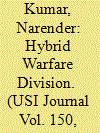

|
|
|
|
|
| Summary/Abstract |
Hybrid and asymmetric warfare are an everyday war that developing countries are facing in a military and economic competitive environment. It is difficult to categorise hybrid war as military or quasi military challenge but it has elements of military and non-military domains. This article examines why Hybrid warfare is a necessity for India and therefore development of hybrid warfare capabilities is imperative because, the state may be under attack but unaware of who is attacking, what is he attacking and how is he attacking. To react to such a threat, where lines of peace and war are blurred, India must build hybrid warfare capabilities for dynamic response to ambiguous and alternative wars. The threat may be kinetic, non-kinetic, political, cyber, transnational organised crime, global terrorism, asymmetric conflict, threat to resources, to diaspora and to key infrastructure. Hybrid war cannot be fought in silos; it requires integration of all elements of hybrid war for offensive and defensive operations. Therefore, India needs to develop asymmetric edge and build capabilities to fight ambiguous and amorphous adversaries by synergised application of intelligence, information, cyber, electronic, conventional and unconventional means. For this India requires a new organisation for Hybrid War, a Hybrid warfare Division, the article brings out similar models in some countries which have gone in for it and thereafter gives a suggested organisation and capability development framework for this division.
|
|
|
|
|
|
|
|
|
|
|
|
|
|
|
|
| 5 |
ID:
166133
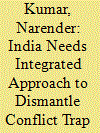

|
|
|
|
|
| Summary/Abstract |
Former President of Pakistan General Zia-ul-Haq once said, “Proxy wars are necessary to ‘keep the pot boiling”. Pakistan, with the help of terror organisations and separatists, has ensured that conflict in Jammu and Kashmir becomes a conflict trap for India. Pakistan is in a position to cause relapse of the conflict to deny space for dialogue and reconciliation whenever situation appears to become near normal. It is imperative to understand that gestation period for conflict resolution under such circumstances is long and thus the objective should be to adopt structured approach to achieve enduring peace. Though there may be a debate whether we are winning this war or it has reached a stage of stalemate, but strategy certainly is not failing in its entirety. Institutions of governance and democratic process have not collapsed and the instability has been restricted to Kashmir valley by sustained military operations and administrative initiatives. Though there may be a requirement to reorient and review the overall strategy, but the bottom line is to ensure that the terror organisations are made powerless and denied public and private space. Pulwama attack has displayed how brutal terrorists can be; however, this strategy is likely to bounce back on terror organisations and sooner or later genuine resentment among the masses against the acts of extreme brutality will rise. Emergence of new political wave is a welcome step and may challenge main stream political parties. This could be seen as the rise of youth against the dynastic politics and may bridge the gap between the youth and the State. Overall objective of the state should be to ensure that people feel empowered rather than disempowered.
|
|
|
|
|
|
|
|
|
|
|
|
|
|
|
|
| 6 |
ID:
112227
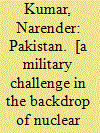

|
|
|
|
|
| Publication |
New Delhi, KW Publishers Pvt Ltd, 2011.
|
| Description |
30p.
|
| Series |
Manekshaw Paper No.33
|
|
|
|
|
|
|
|
|
|
|
|
Copies: C:1/I:0,R:0,Q:0
Circulation
| Accession# | Call# | Current Location | Status | Policy | Location |
| 056418 | 355.021709549/KUM 056418 | Main | On Shelf | General | |
|
|
|
|
| 7 |
ID:
151882
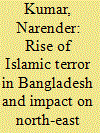

|
|
|
| 8 |
ID:
169699
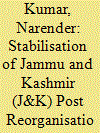

|
|
|
|
|
| Summary/Abstract |
In a historic move, Parliament of India has amended Article 370 and revoked 35A for complete merger of Jammu and Kashmir (J & K) with India. The bifurcation of the state is another strategic move to liberate Ladakh from political arm twisting by Valley based leadership. It will pave the way for development and empowerment of this sensitive region. It has sent message to China and Pakistan that India can no more be blackmailed on J & K in the name of collusive threat. Pakistan and separatists were confident that Article 370 and 35A are the instruments cast in iron and no political dispensation in Delhi can alter this status quo. This notion stands shredded today. It will be a miscalculation to assume that this bold move will have any impact on proxy war or terrorism. There is a possibility that instability in Kashmir may rise before it limps back to normalcy. Thus, government will have to guard and block all perils of corridors. Pakistan and separatists would try and disrupt the stability and thus, the government will have to take all precautions to deal with it firmly.
|
|
|
|
|
|
|
|
|
|
|
|
|
|
|
|
| 9 |
ID:
172634
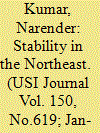

|
|
|
|
|
| Summary/Abstract |
Conflict resolution and communication connectivity are key to stability in the North-east for implementation of Act East Policy of India. The developing nexus between drug and weapon cartels, insurgents and rogue intelligence agencies (Inter-Services Intelligence (ISI) of Pakistan and Chinese Intelligence agencies) will be a greater challenge to the state to bring peace and development in the region. In fact, there is an endeavour to reorganise and realign the anti-talk factions so as to maintain instability in the Northeast. The objective is to revive, resuscitate and energise the insurgent groups by coordinating and organising them under umbrella organisations to avoid inter-group clashes and competition. The objectives are clear to keep India engaged within the Northeast and keep it out of Myanmar to deny land connectivity with the ASEAN and South East Asian nations. The instability in the Northeast is now slowly shifting in the hands of external players and the larger strategic objective is to choke development and economic, political and cultural linkages with ASEAN and South East Asia.
|
|
|
|
|
|
|
|
|
|
|
|
|
|
|
|
| 10 |
ID:
096334
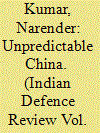

|
|
|
| 11 |
ID:
154268
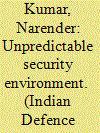

|
|
|
|
|
| Summary/Abstract |
The overall effort should be to enhance operational capabilities in an evolving security secenario. The Indian Armed Forces cannot remain immune even in changing times to serve narrow parachial bojectives. The integration and restructuring of the armed forces is warranted by the emerging security environment. In the backdrop of the above, the integrated command structure may be tri-services or even bi-services depending upon the nature of threat to India. It revolves around the mission and unity of command to fight a successful war and in turn, theatre battles. What is important is that decision time should be reduced and simultaneity of application of military force be achieved in a highly volatile and fast changing war scenario. The services need to keep national interests in mind rather than proecting their own turf.
|
|
|
|
|
|
|
|
|
|
|
|
|
|
|
|
| 12 |
ID:
154409
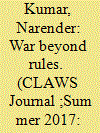

|
|
|
|
|
| Summary/Abstract |
States were known to employ military capabilities that were conventional
in nature. The enormous destructive power of conventional capabilities
and nuclear arsenals has made conventional wars cost-prohibitive and
thus the application of non-state actors and irregular forces against states
is becoming the new normal of waging wars. The beginning was made
in Afghanistan when the Taliban and the Mujahids were employed, with
state patronage, against the Soviet Union. Post-Cold War era, a new
warfare has emerged, wherein non-state actors with state patronage, have
begun to utilise military capabilities that were traditionally attributed only
to states. Instead of relying solely on irregular tactics, they have surprised
their adversaries with conventional arsenals including air-defence systems,
missiles, rockets, and artillery.
|
|
|
|
|
|
|
|
|
|
|
|
|
|
|
|
| 13 |
ID:
155603
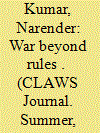

|
|
|